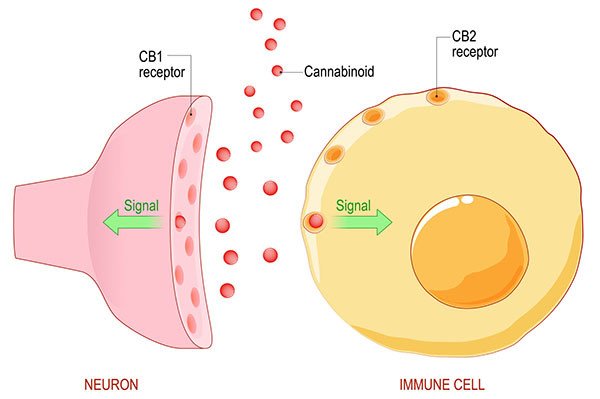The endocannabinoid system is complex but extremely important to understand. There are 12 distinct systems within the body. The most commonly known would be your nervous or immune system. These systems are specifically designed to support human life, essential controlling and protecting your body.
The medical world is constantly advancing through new discoveries, techniques and research. There are many ‘unknowns’ about the body and its functions, but with new technology we are able to learn more than ever before. This relates to the unfamiliarity of the endocannabinoid system as it wasn’t discovered until the 1970’s.
The endocannabinoid system is exceptionally intricate and can be difficult to explain without getting overly scientific. Its main function is to maintain homeostasis at a cellular level in the body. Homeostasis is the process of managing your internal environment, keeping your body in balance. Homeostasis is commonly known for balancing temperature, sugar levels, blood pressure, oxygen and regulating nearly every essential function in your body.
HOW DOES THE ENDOCANNABINOID SYSTEM MAINTAIN HOMEOSTASIS?
First, it’s important to understand that the endocannabinoid system has been present in your body since even before birth. It is an extremely crucial physiological system aimed at maintaining and regulating overall health.
The endocannabinoid system contains 3 critical elements:
1. Endocannabinoids (Endogenous Cannabinoids)
2. Receptors
3. Enzymes
Endocannabinoids are compounds naturally produced within the body to maintain stability, known as a mediator of cell communication. The endocannabinoid system functions through enzymes creating or breaking down endocannabinoids, and these endocannabinoids then attach to receptors which are responsible for internal regulation.
Let’s break this down. When you’re hungry you have a sandwich, it leaves you satisfied and more energized than before. Once you eat, you’re no longer hungry and you now have the nutrients and energy needed to restore your body. The ‘sandwich’ is made up of many different ingredients, bread, lettuce, tomato etc. and all of these components come together to make a satisfying meal. Think of enzymes as the ingredients, these enzymes create a ‘sandwich’ which would act as the endocannabinoids, and the receptors would be emulated by the stomach. The endocannabinoids attach to receptors, communicating chemical messages which activate regulation of your internal system, just as eating a sandwich would curb your hunger through the nutrients it provides.
ENDOCANNABINOIDS AND CANNABINOIDS
Now that we have the base of the system explained, let’s take a more detailed look into endocannabinoids. Endocannabinoids are technically referred to as “endogenous cannabinoids” which are compounds formed in the body. These are the compounds that attach to receptors, signaling distinctive messages to maintain and establish homeostasis. Endocannabinoids are also mimicked in other substances outside of the body, which we call cannabinoids.
Cannabinoids aid the system by functioning and behaving as ‘endocannabinoids’, also known as cannabinoids naturally produced by the body.
The endocannabinoid system responds to many different health conditions such as stress, illness and even injury. This system is also responsible, as we know, for maintaining homeostasis which has a direct impact on ph. levels, brain control, temperature, motor coordination and many other bodily functions. Cannabinoids and endocannabinoids initiate this process, which is why it is important to understand the structure and process of how these compounds work.
Cannabinoids are found in many different forms, and you most likely have items in your pantry that contain cannabinoids. Some commonly known foods containing cannabinoids include dark chocolate, flax seed, black pepper and many more. These cannabinoids interact with enzymes in the body and produce distinct messages, prompting responses from receptors and stimulating the endocannabinoid system.
WHY DO WE NEED ADDED CANNABINOIDS IF OUR BODY ALREADY PRODUCES THEM?
We call this the “if something isn’t broken, why fix it?” mentality. In this case, it’s important to understand that our bodies internal and external systems are very complex. More often than not, individuals disregard what their body is signaling to them, or misconstrue signals. Your body can be easily thrown out of balance, neurologically and physically. When your body is out of balance it means there is a breach or in one or more of our systems operations.
When our body isn’t functioning at full efficiency, we look to see what’s changed, how the balance was disrupted, or what isn’t being regulated. Generally, this means that the process and maintenance of homeostasis has been impaired, which is why we look to our endocannabinoid system. The endocannabinoid system can be altered by a multitude of conditions; stress, poor diet, consumption of alcohol, prescription and non-prescription drugs, illness and even genetics. All of which are fairly common in most individuals, and of which impede our bodily systems normal operations. Adding cannabinoids to your body provides support and improves functionality of the endocannabinoid system when it is malfunctioning.
Going back to the example of a sandwich, imagine that your sandwich is missing key components. Let’s remove the protein and lettuce, inhibiting your body from gaining crucial nutrients and energy. The sandwich is incomplete, and when consumed, you are still hungry and your energy levels are low. You aren’t functioning at full capacity because you only consumed a portion of the meal your body needed.
Now, if our enzymes are not creating or breaking down our endocannabinoids correctly, the message sent to the receptor will not be fully understood and could provide faulty information. This miscommunication causes a disruption in homeostasis, leading our body to become unbalanced. Cannabinoids assist and stabilize these deficient messages to regenerate homeostasis.
WHAT DOES CBD HAVE TO DO WITH THE ENDOCANNABINOID SYSTEM?
CBD is an all-natural substance made up of cannabinoids. CBD plays a big part in the endocannabinoid system as it was the original catalyst in discovering the system. CBD cannabinoids influence receptors and enhance natural levels of endocannabinoids. CBD specific cannabinoids are formulated chemical compounds with high cell counts. These cells combined within the body directly affect the endocannabinoid system, assisting and prompting the process of regulation. This is one of the main reasons why CBD is becoming such a popular alternative to other medicinal therapies.
The endocannabinoid system is not only present in humans, it is also found in animals. This means that your pets maintain cellular homeostasis through the endocannabinoid system. In regard to CBD pet products, the substance acts similarly to CBD in humans. It contains cannabinoids which provide support to the endocannabinoid system, helping maintain regulatory body function. This is just one of the many reasons why CBD has become a popular health product for pet owners.
WHERE TO GO FROM HERE:
The endocannabinoid system is very intricate, and imperative in the process of maintaining homeostasis. The science behind how we function is reliant on the internal and external structure of our body systems. The complexity of our biological make-up can be confusing and it’s important to know why CBD has been such a topic of conversation within the medical community.
If you’re interested in learning more about CBD, or how to add CBD to your daily regimen check out our FAQ and/or shop pages!


